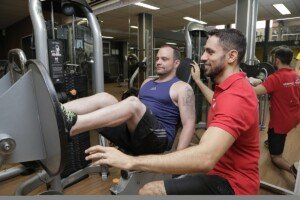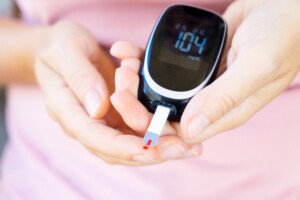If you’re scared you might develop type 2 diabetes, then you should be working to increase your muscle mass.
Bulking up is not necessary, but the more muscle tissue you have, the more protection you’ll have against developing a prediabetic state.
Type 2 diabetes is strongly linked to lifestyle choices. About 80% of those with this metabolic disease are overweight.
Overweight and especially obesity are potent risk factors for numerous medical conditions.
However, as far as the likelihood of developing a medical condition including type 2 diabetes, the overweight person who lifts weights has a big advantage over the overweight person who doesn’t.
To put this in an even brighter light, an overweight woman who’s 5’7 and 220 pounds — and doesn’t exercise – has a high risk for insulin resistance (prediabetes), which can morph into type 2 disease.
But suppose she starts lifting weights – training fiercely and hard – realizing that this is one physical endeavor for which she’s on an even playing field with smaller women.
Over time she gains 15 pounds of muscle – but her scale weight remains at 220. She’s down a few dress sizes and looks firmer. But she’s still overweight.
That additional 15 pounds of lean muscle tissue will go a long way at lowering her risk of type 2 diabetes – even though she still has the risk factor of being overweight.
Muscle Gained = Lower Risk of Type 2 Diabetes
“Lean muscle utilizes insulin much more efficiently than fat,” says Susan L. Besser, MD, with Mercy Medical Center, Baltimore; Diplomate, American Board of Obesity Medicine and board certified by the American Board of Family Medicine.
“Fat tends to ‘hoard’ insulin and not release it so it can do its job. Muscle allows insulin to work properly to move sugar into the cells to be used as energy.
“And of course, fat cells store sugar but don’t use it as well as muscle cells — which are better designed than fat cells to convert sugar to energy.”
Lifting weights – intensely enough to increase lean muscle mass – will create more insulin-receptor sites on muscle cells. This will increase the uptake of blood sugar (glucose), which is shuttled to the muscle cells via insulin.

Depositphoto.com
In type 2 disease, the pancreas produces insulin, but the glucose transport and/or uptake system is impaired.
Quite simply, more muscle means an improvement in glucose metabolism. If you’re afraid of getting type 2 diabetes and have failed at numerous weight loss attempts – then hit the gym. And hard.
Weight Loss Not Necessary to Build Strong Muscles
This is not marathon running. It’s weightlifting. In the war against type 2 diabetes, it’s never too soon to begin picking up barbells.

Whether you’re overweight or not, you do not need a bodybuilder’s program to gain muscle to guard against type 2 diabetes.
You just need to gain muscle mass.
Best Way to Get Strong (Gain Muscle)
Strength = more muscle. But more muscle doesn’t always mean more size. This is why a 130-pound woman can deadlift 315 pounds. She’s not bulky big, but the strength comes from concentrated, compact muscle mass that’s been gained from training.
Thus, you need not worry about stronger muscles making you bigger than your overweight size.
You’ll want to use your gym time wisely, that is, focus on exercises that target the largest muscle groups, especially more than one such group at once.
• Deadlift (barbell)
• Squat (barbell, kettlebells or dumbbells)
• Chest press (flat or incline barbell, flat or incline dumbbell)
• Back (lat pull-down, seated row)
• Shoulder press
• Leg press

Freepik.com

Shutterstock/Pressmaster

Depositphotos.com

Rafaelqcn, CreativeCommons
Isolation moves such as biceps curls, dumbbell side lifts, leg extensions and leg curls are not necessary to build sufficient muscle mass to help ward off type 2 diabetes.
Training Format
There’s no single template. But to make things easy, I recommend doing the legs on one day, the back on a second day and the chest/shoulders on a third day: strength training three times/week, 45 minutes per session.
The deadlift can be done on either the leg day or back day.
An easy rule to follow is that if you can do more than 12 repetitions, the weight is too light.
An 8-12 rep max is what you want to shoot for, though for the deadlift and barbell squat, this will be quite grueling. But hey, you might end up thriving on it.
The alternative is a 5-7 rep max. You’ll still gain lean muscle tissue, but you won’t see as much of a sculpting effect. The lower-range rep max has a different feel than does the higher range.
But either protocol will work for the person (overweight or not) who wants to scare off type 2 diabetes. Rests can be 75 seconds to two minutes in between sets.
Experiment with what works best for you as far as rep ranges. But just remember: if you can do 13 reps…increase the weight!
 Dr. Besser provides comprehensive family care, treating common and acute primary conditions like diabetes and hypertension. Her ongoing approach allows her the opportunity to provide accurate and critical diagnoses of more complex conditions and disorders.
Dr. Besser provides comprehensive family care, treating common and acute primary conditions like diabetes and hypertension. Her ongoing approach allows her the opportunity to provide accurate and critical diagnoses of more complex conditions and disorders.
 Lorra Garrick is a former personal trainer certified through the American Council on Exercise. At Bally Total Fitness she trained women and men of all ages for fat loss, muscle building, fitness and improved health. [email protected]
Lorra Garrick is a former personal trainer certified through the American Council on Exercise. At Bally Total Fitness she trained women and men of all ages for fat loss, muscle building, fitness and improved health. [email protected]
.

























